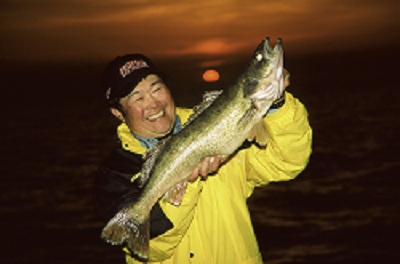Opinions on what role color plays in making fish bite are as varied as the colors of the rainbow. Color, when it comes to fishing, can be a controversial topic. One thing for sure is that every single angler has his or her favorite color and they typically have an opinion on which color makes fish bite. Buck Perry, the father of structure fishing and one of the sport’s greatest thinkers, has said that the keys to fishing are depth and speed, but he added that, in his opinion, color is a trigger.
Think about your own experience. We’ve all seen those days when the color of our lure or jig seemed to make all the difference. We have the right bait in the right color at the right place only to have fortune turn a blind eye to us. We break off the only one we had.
This can be very frustrating, because thinking you have the color factor figured out can greatly increase your confidence. Lose that confidence and you might as well call it a day. Believe it or not, we’ve seen instances where one color in one boat is the only color catching fish, while a completely different color (same lure) in another boat just a quarter-mile away is the ticket.
The Eyes Have It
With the exception of spawning, a fish’s life focuses on one reality–eat or be eaten. Over many centuries, natural selection–survival of the fittest and most adaptable–has resulted in a design that equips fish wonderfully to meet the challenges they face in their particular niche of their underwater world.
For example, species like catfish often hunt prey in dingy water. As a result, they’ve evolved to rely heavily on their sense of smell. Anglers who chase them use concoctions aptly named ‘stink baits’ to catch them.
All fish have lateral lines that run the length of their bodies. They sense vibrations emanating from their prey or an approaching predator as they swim. The extent of the development of the lateral line of a particular species appears to depend on the development of its other senses. Likewise, all freshwater species, except for a handful that evolved deep in pitch-black caves, use their eyesight to some extent, some more than others.
How Eyes Work
Eyes have two kinds of receptor cells. Cone cells are color sensors used in daylight. Rod cells are for low-light and darkness, and they detect only black, white and shades of gray. As the sun sets and rises again, the transition from cones to rods and back again happens at different speeds in different species. As a result, some predators, such as walleyes, are at an advantage in low-light periods because their eyes adjust relatively quickly. As we know, walleyes feed heavily at dawn and dusk.
Walleyes also are equipped to see in virtual darkness. They have large pupils, which gather light. Like cats and white-tail deer, walleyes also have a reflective layer on their retinas known as tapetum lucidum. It helps concentrate light once it has entered the eye. As a result, moonlight is enough of a light source for them to hunt. Their eyes are far more sensitive to light than our own.
Cone development, and therefore the ability to sense color, varies among species. Scientific analysis of cones allows us to estimate which of the colors of the spectrum — red, orange, yellow, green, blue and violet — each species sees.
For example, fish biologists believe largemouth bass respond best to red. That color is followed closely by violet, which scientists think resembles red to a bass. Those same scientists think bass see black, yellow and blue almost as one and the same.
Based on cone development, walleyes should see the lower end of the spectrum best — red, orange, yellow and green. Colors at the upper end of the spectrum, blue and violet, probably appear black to them.
Here’s another factor to take into account: colors appear to change as the bait descends into deeper water. To understand that, you must first understand this: the color an object appears does so because it is absorbing all the other colors of the spectrum and reflecting only the color you see. Therefore, something appears red because it’s reflecting red and absorbing orange, yellow, green, blue and violet. Something appears white because it reflects every color equally. An object appears black because it absorbs them all.
 The rich colors of an above-water sunset belie the low light conditions fish face as they play out nature’s game of predator and prey. Read all about the art and science of color from the playbook of Hall of Fame angler Ted Takasaki, who poses here with a dandy prime time walleye that fell for a Lindy X-Change jig. The rich colors of an above-water sunset belie the low light conditions fish face as they play out nature’s game of predator and prey. Read all about the art and science of color from the playbook of Hall of Fame angler Ted Takasaki, who poses here with a dandy prime time walleye that fell for a Lindy X-Change jig. |
Now, add this to the formula. At a depth of 20 feet, almost all of the red contained in sunlight is absorbed by water - even in clear water. So, a jig that appears red on the surface, appears black 20 feet down because there is no red light for it to reflect and the water has absorbed every other color that reaches the jig. On the other hand, orange, yellow and green penetrate to depths of 30 feet and below |
Water clarity, of course, is another ingredient in the color formula. The less light that reaches a bait, the faster the color fades. Resort to baits that rattle and vibrate when water clarity drops to almost nothing.
The lesson is this: apparent color of a jig or lure varies with the depth and the clarity. That makes the new technology of luminescence all the more important. We’ll discuss more on that topic later.
The bottom line to all of the scientific mumbo jumbo: most fish cannot eat what they cannot see.
Seeing Is Believing
Lure color theories and opinions evolved from a combination of experience and scientific knowledge. Anglers first toyed with natural colors to imitate the forage that gamefish eat. Patterns on the lure, such as perch stripes, allow fish to target these lures vs. color alone.
‘Unnatural’ colors derived from experimentation. Red and white were among the first combinations that proved successful for everything from northern pike to trout. It was a common color combination used over fifty years ago and is still popular today. Orange and black was another. Metallics like silver and copper appeared on the market, too. ‘Firetiger’ is a bright combination of yellow, green, and orange which has also been around for many years. ‘Hot’ colors, like chartreuse, yellow, and green are fairly modern additions.
So, what’s a fisherman supposed to do? It’s impossible to carry every color of every bait you might need, and there’s no doubt that colors have caught more fishermen than fish.
We recommend that you have a variety of colors for various species of fish and light conditions–some dark, some light and some fluorescents.
Here’s an assortment to make it simple. Take along some whites, silvers, and grays. For darks, keep blacks, browns, purple, and dark green handy. Yellow fits the in-between category. Add in hot colors, like bright reds, pink and chartreuse green and yellow, along with some metallics, and you’ve got things covered.
Common sense says use natural colors when water is clear. Try high-vis colors like chartreuse when water is murky. As always, experiment by giving the fish a smorgasbord. Let the fish tell you what they want. Don’t allow the rules of thumb to limit you. Remember, subtle changes in color can make a big difference.
Lindy recently introduced a new line of jigs called X-Change. This new introduction allows anglers to make quick changes in the color or weight of their jig without re-tying. Re-tying was always an inhibitor to switching colors and now there’s a solution with X-Change.
But, you’re not done yet. Years ago, Great Lakes fishermen discovered glow strips catch salmon and trout. It was a natural for the idea to spread.
Soon, anglers were pasting glow eyes on jigs. New technologies have led to luminescent paints which allow tackle manufacturers to offer a wide range of baits that glow for a time on their own when ignited by a light source. They help fish find baits in low-light conditions, when the water is murky, in deep water, at night or when fish just want that something extra.
Glow jigs have been a Lindy-Little Joe standard for some time. A wider range of Techni-Glo colors, which actually glow in various colors, were added several years ago.
After all, an ‘eye can’t bite what it can’t see.
|



